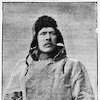Australia looks south
The Challenger visit sparked a revival of interest in Antarctica in the Australian colonies. In Melbourne in 1886, the Australian Antarctic Exploration Committee was established to promote Antarctic science and exploration, including setting up research stations.
But an approach to Melbourne business interests in the early 1890s by Norwegian-born businessman Henryk Bull, seeking support for an Australian-based Antarctic expedition, got no result. Bull returned to Norway and set out from there on a voyage to explore Antarctica while hunting for whales.
Back in Melbourne with his expedition, Bull hired a fellow-Norwegian, a teacher named as a scientist. Both men were in the boat party that later claimed to have made the first landing on Antarctica — a claim later discounted, having been preceded by John Davis (Antarctic Peninsula, 1821) and Mercator Cooper (Victoria Land, 1853).
Borchgrevink made the first collections of plants and rocks from the Antarctic continent. When he secured British funding for another Antarctic venture, this time to winter on the continent, he at last got the attention of Australian scientists. His 1898 Hobart-based Southern Cross expedition — the first to complete an Antarctic winter ashore — included a physicist from Tasmania named Louis Bernacchi.


